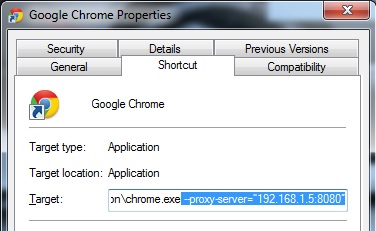问题
I did a search in google and also in this forum. But I could not see any useful information.
Now, I use both IE for Work VPN and Chrome for personal activities and need to use different proxy settings.
Google Chrome doesn't have its own Network Settings. It uses the settings provided by your Operating System, so they will always be the same as IE.
So the question is Whether we can have any possible workaround to overcome this and have a standalone proxies for both the browsers, rather than a shared one?
回答1:
Chrome can use its own proxy setting but this function is hidden from UI.
To do this, you'll have to set up a shortcut in the desktop first (or actually use one that you already have), and then adjust target of the shortcut.
- Go to the shortcut you use to open Google Chrome.
- Right-click the shortcut and select Properties.
- To use a different proxy server, go to the Target text box. Go to the end of the text, add a space and input the following:
--proxy-server="ipaddress:port"

So if your proxy has IP 192.168.1.5 and uses port 8080 you should add something like this --proxy-server="192.168.1.5:8080" to the end. Make sure to include the quotes.
回答2:
Right click on the chrome shortcut, then go to properties, select target, and add the following without changing the previous thing:
--proxy-server="ipaddress:port"
Then click on apply, and click on ok.
来源:https://stackoverflow.com/questions/22033401/workaround-to-have-a-standalone-proxy-settings-for-chrome